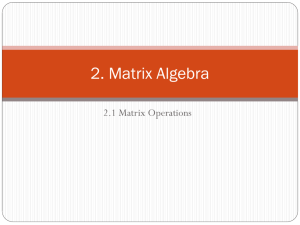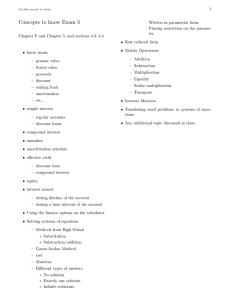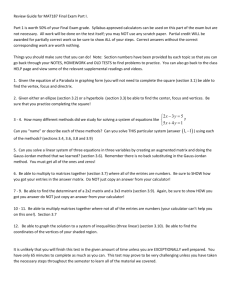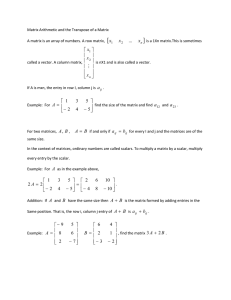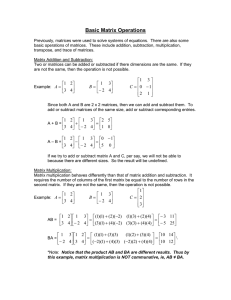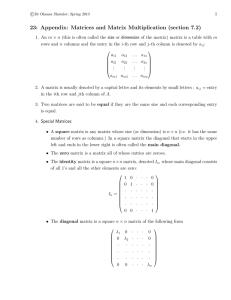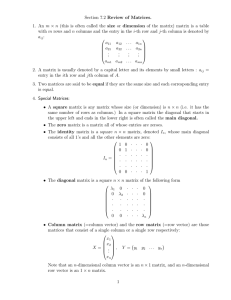1MA01: Linear Algebra Sinéad Ryan September 22, 2014 TCD
advertisement
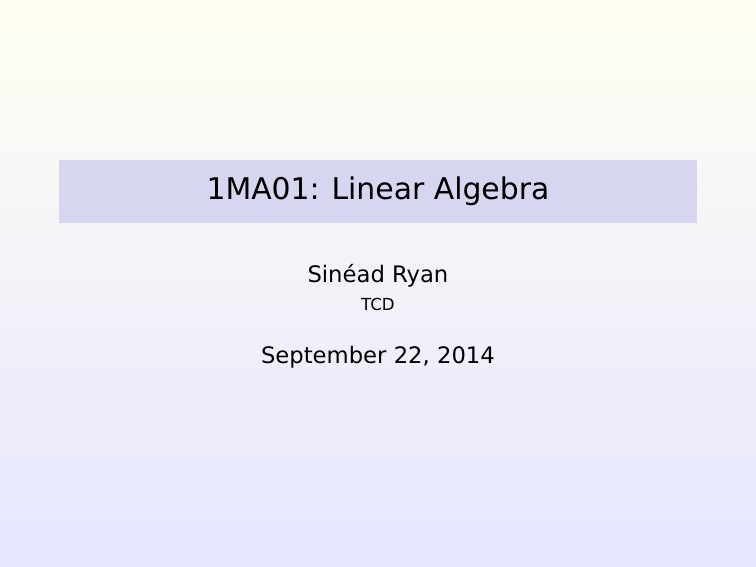
1MA01: Linear Algebra Sinéad Ryan TCD September 22, 2014 Introduction In this section on linear algebra we discuss properties of matrices and examples of their application eg to population growth. Matrix A compact wat of representing or storing information organised in a rectangular array of numbers. A matrix is usually (in these notes) denoted with a capital letter. If a matrix A has n rows and m columns then its size is n × m. E.g. A= and 1 2 3 3 2 1 isa 2 × 3 matrix 0 −1 A = 1 −2 isa 3 × 2 matrix 2 −3 If n = m ie number of rows = number of columns then it is called a square matrix E.g. 2 1 A= isa 2 × 2 matrix 4 5 To refer to a number in a matrix A (called an entry) use its row and column postition e.g. entry a23 is found at row 2 and column 3. E.g. 1 2 3 A= then a23 = 1 3 2 1 Note that entries can be integers (±), real numbers or complex numbers (or a mixture). Matrix Addition and Subtraction Define the sum/difference of two matrices of the same size by adding/subtracting corresponding entries. definition A, B two n × m matrices. Then C = A + B is also n × m and cij = aij + bij . Also D = A − B is also n × m and dij = aij − bij . E.g. for the three matrices 3 0 −6 4 −2 0 3 9 A= ;B = ;C = −1 7 −3 5 −2 10 2 1 we compute: 3 0 −6 −1 7 −3 3 0 −6 −1 7 −3 4 −2 0 5 −2 10 3 + 4 0 − 2 −6 + 0 = −1 + 5 7 − 2 −3 + 10 7 −2 6 ; = 4 5 7 A+B = + 4 −2 0 A−B = − 5 −2 10 3 − 4 0 + 2 −6 − 0 = −1 − 5 7 + 2 −3 − 10 −1 2 −6 = ; −6 9 13 And eg A + C: not defined since the matrices are different sizes. Matrix Products Some notation first: a row matrix is a matrix with 1 row; a column matrix is a matrix with 1 column. To multiply 2 matrices must have: number of columns in the first matrix = number of rows in the second. E.g. The product of A2×3 × B3×2 can be calculated. The product of A2×3 × C2×2 can not be calculated but C2×2 × A2×3 is defined. Also and importantly: the order of multiplication matters, so AB 6= BA in general. Another way of saying this is that matrix multiplication is not commutative. definition of matrix multiplication: Given, An×k , Bk×m then C = AB is an n × m matrix with entries cij = ai1 b1j + ai2 b2j + . . . + aik bkj The entry at i, j is the sum of products of corresponding entries in the ith row of A with the jth column of B. An example is the easiest way to see what is going on. E.g Consider 2 matrices 2 −1 1 −3 0 3 ,B = 5 A= −2 −1 4 −4 −5 (check the sizes to verify they can be multiplied and C = AB will be size 2 × 2) C = 1 −3 0 −2 −1 4 2 −1 3 5 −4 −5 1(2) − 3(5) + 0(−4) 1(−1) − 3(3) + 0(−5) = −2(2) − 1(5) + 4(−4) −2(−1) − 1(3) + 4(−5) 2 − 15 + 0 −1 − 9 + 0 = −4 − 5 − 16 2 − 3 − 20 −13 −10 = −25 −21 Notice these numbers are not obvious given the original matrices! Now try BA: this is a 3 × 2 matrix by 2 × 3 Scalar multiplication if c is a number (scalar) and A a matrix then cA is the matrix where every entry inA is multiplied by c. 1 2 E.g. if c = 2 and A = then 3 5 cA = 2 1 2 3 5 = 2(1) 2(2) 2(3) 2(5) = 2 4 6 10 and Ac = 1 2 3 5 2= 1(2) 2(2) 3(2) 5(2) = 2 4 6 10 = cA. Scalar multiplication is in general commutative. Also note that the matrix A can be any size. Special matrices Zero matrix The zero matrix can be any size with all entries zero Identity matrix defined for square matrices only: I= 1 0 0 0 0 1 0 0 .. .. .. . . . 0 .. . 0 1 ie one on the main diagonal, zero elsewhere. Check that IA = AI = A for any square matrix A you try → I is the identity for matrix multiplication. Some matrix properties Transpose of A If A is an n × m matrix then AT is m × n, obtained by swapping the rows and columns of A. AT is called the transpose of A. E.g. A= 1 1 7 8 2 0 −1 3 4 6 ; B= −12 −7 C= −7 10 ; ; 1 8 AT = 1 2 7 0 −1 4 T B = 3 6 −12 −7 CT = =C −7 10 In the last example CT = C and C is called a symmetric matrix. properties of transpose There are lots of nice properties of transpose including T AT = A (AB)T = BT AT . This property can be proved as follows: BT AT = (bik )T (akj )T = bki ajk = ajk bki = (AB)ji = (AB)Tij (A + B)T = AT + BT . Gauss-Jordan Elimination Solving systems of linear equations Consider 3x − 2y = 1 −x + y = 1 What x and y solve these simultaneous equations? Of course, you can easily find the answer with pen and paper (x = 3, y = 4)! But now, what if there were many more maybe thousands of unknowns and equations. This is much harder to solve with pen and paper and a systematic, algorithmic method that can easily be written as a computer programme for numerical solution is preferable. Gauss-Jordan Elimination is such a method Start by noting that the system of equations can be written as a matrix equation: Ax = b where A is the matrix of coefficients, x is the set (column matrix/vector) of unknowns and b is the column matrix formed from the numbers on the right-hand-side of the equations. 3 −2 x ,x= and In our example above A = −1 1 y 1 . b= 1

